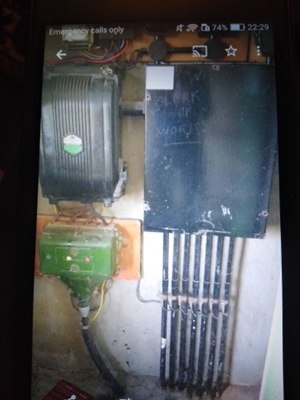
31 July 2007 09:55 AM    |
briandoherty Posts: 313 Joined: 08 May 2004 |
| Mr P, I apologise in advance for the length of this post! I got the colour wrong in my previous "second-hand" quote regarding BS4553 (split concentric cables) ( I said "blue" instead of "black")! However, now I'm back in the office, I can confirm the actual wording in the standard is as follows (underline emphasis is mine): "BS4553-1:1998 Specification for 600 / 1 000 V single-phase split concentric electric cables - Part 1: Cables having PVC insulation... 1 Scope This British Standard specifies requirements for construction and gives methods of test for PVC-insulated single-phase split concentric cables for operation on an earthed neutral system at nominal voltages up to and including 1 000 V between phases and 600 V to earth. The cables specified in this part of BS4553 have a central phase conductor insulated with PVC and a concentric layer comprising bare copper wires (earth continuity conductor) and copper wires covered with extruded polymer (neutral conductor)... 6 Insulation The insulation shall be PVC compound type TI 1 conforming to BS 7655-3.1... 9.1 Neutral conductor ...To distinguish the neutral conductor from earth continuity conductor, each wire shall be covered by extrusion with a black polymeric compound to a diameter approximately the same as that of the individual wires of the earth continuity conductor. 9.4 Application of concentric layer ...The wires forming the neutral conductor and earth continuity conductor shall be applied in individual groups over the insulation or bedding with string separators. Either one or two string separator(s) shall be located on either side of the group of bare copper wires to separate it from the group of coverered wires." Note that the covering of the neutral conductor is NOT described as, or required to be, INSULATION. It is there simply to ensure the neutral conductor is easily distinguishable from the earth continuity conductor. Unlike the INSULATION required on the phase conductor, which must comply with the relevant standard (BS 7655-3.1), there is no such requirement for the COVER on the neutral conductor. This is not to say that the material covering the neutral conductor will not pass an Insulation Resistance test, but just that it is technically NOT insulation; what would happen if it failed an IR test (neutral to earth) next week, next year, whatever... In fact, with regard to testing, BS 4553 states the following: "Annex F (normative) Insulation resistance test After completion of the voltage test given in 16.3, measure the insulation resistance between the central phase conductor and all the wires comprising the concentric layer, after applying a minimum voltage of 500 V d.c. for 1 min." There is no requirement to test between neutral and earth, because on paper there is no "insulation" between them. I am aware that some specifications are written to overcome the lack of insulation on the neutral conductor of "standard" split concentric cable to BS 4553. For instance, here is an excerpt from one such specification (regarding street lighting supplies) (the underline emphasis is mine): "Split Concentric Cable Specific Requirements : Cable for electricity supply complying with BS 4553 (unless stated) and having a voltage rating of 600/1000V, and comprising; ... (d) Neutral Insulation - black PVC compound providing an Insulating layer. This PVC compound shall comply with type T11 of BS 6746. It shall be applied by an extrusion process and shall form a compact homogenous layer. The final conductor plus insulation diameter shall be approximately the same as that of the individual wires in the earth continuity conductors... Note : Subsection (d) above deviates from BS 4553." So, unless you are using a non-standard split-concentric cable, the neutral conductor is NOT insulated. Brian |
 The pic is a 1960s BNO, still in use!
The pic is a 1960s BNO, still in use!perspicacious:
but a building network, by definition, isn't a consumer's installation.
Where is this defined Andy?
Regards
BOD
“consumer” means any person supplied or entitled to be supplied by a supplier but in
regulations 24, 25 and 26 shall not include, in respect of any supply to meet haulage or
traction requirements, any person who is an operator of a network within the meaning of
Part I of the Railways Act 1993(b);
“consumer’s installation” means the electric lines situated upon the consumer’s side of the
supply terminals together with any equipment permanently connected or intended to be
permanently connected thereto on that side;
“distributor” means a person who owns or operates a network, except for a network where
that person is an operator of a network within the meaning of Part I of the Railways
Act 1993;
“supplier” means a person who contracts to supply electricity to consumers;
A consumer shall not combine the neutral and protective functions in a single conductor
in his consumer’s installation.
This cable is BS 7870, split concentric, a distribution (DNO) cable. This is used in a "wiring regulations" environment, if it is not recognised in the regs it must be detailed as a "deviation."
We're about to take you to the IET registration website. Don't worry though, you'll be sent straight back to the community after completing the registration.
Continue to the IET registration site